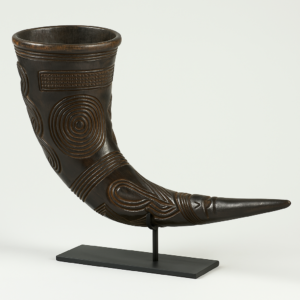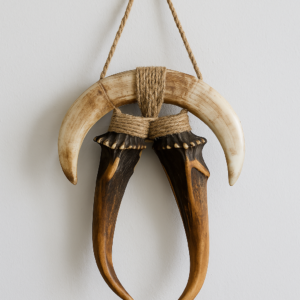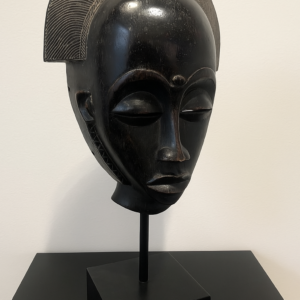“The Fiery Bull Spirit,” meaning “Nguruwe wa Moto” in Swahili, is a spectacular example of ritual African craftsmanship that fuses animal power with divine fire. This striking ceremonial mask, rendered in bold tones of blood red, ash black, bone white, and earthy brown, is inspired by the ceremonial zoomorphic masks of the Bwa and Bobo peoples of Burkina Faso and Mali. These masks play a central role in spiritual performances meant to restore harmony between humans, the earth, and the ancestral forces that bind them.
At first glance, the mask exudes energy—a totem of vibrant vitality and fierce protective force. With a wide snout and tall, arching horns, it immediately conjures the image of a bull or buffalo, animals traditionally revered across African cultures for their power, determination, and connection to fertility and land stewardship. The horns, painted black and rising confidently from the crown, frame the top of the piece like a crescent gate to the heavens. These horns were not simply decorative in ancient performances; they symbolized the divine channel through which spirits could descend during dance rituals.
The entire mask is composed of carved wood, shaped and painted by hand with natural pigments derived from clay, charcoal, and plant dyes. The central form features an exaggerated, rounded forehead and snout—a nod to both animal strength and supernatural reach. Its surface is coated in radiant red, a color long associated in African symbology with life force, spiritual vitality, and transformation. Red is the color of ritual fire, sacrifice, and renewal—it animates the mask, giving it a soul of movement even in stillness.
Lining the mask’s snout and crest are bold stripes of white and black, likely symbolic of duality and ancestral balance. White traditionally represents clarity, the world of the ancestors, and the spiritual realm. Black, in contrast, symbolizes the unknown, the hidden, and the raw energies that must be navigated during a rite of passage. These visual contrasts give the piece depth beyond form, serving as an abstract roadmap for spiritual awakening.
In performance, Nguruwe wa Moto would have been worn by masked dancers—often young initiates or spiritual leaders—during agricultural festivals, funerary rites, or initiation ceremonies. The dancer, hidden beneath the massive mask and costume of raffia and bark, would channel the spirit of the beast. Their movements would mimic the behavior of the animal, invoking fertility, rainfall, harvest, or ancestral guidance. As the mask moved through the village, it became a living bridge between the physical and metaphysical worlds.
The eye holes are narrow and functional, allowing the dancer to see just enough while immersed in trance. On the side of the mask is a circular piercing—either for symbolic vision or for ventilation during dance. Below the snout, jagged edges suggest teeth or a stylized mouth, reinforcing the mask’s wild vitality and the balance between creative and destructive power.
The rear of the mask is lined with remnants of bark or fabric once used to attach the piece to full-body regalia. These elements highlight the completeness of the spiritual performance—the mask was never meant to exist in isolation. It was the head of a divine creature brought to life in ceremony.
In modern interior and curatorial settings, Nguruwe wa Moto offers more than exotic visual flair—it provides a deep portal into African cosmological thinking. This mask serves as a conversation between form and function, myth and motion, rooted culture and contemporary design.
Whether placed in a curated gallery, private collection, spiritual space, or even a high-concept interior setting, this piece becomes a beacon of strength, resilience, and ancestral presence. It is a reminder of the primal forces that shaped civilization, and of art’s ability to serve both as protection and revelation.
Collectors of African heritage art, museums, curators of ritual objects, and spiritual practitioners will find in Nguruwe wa Moto an artifact that does not merely represent culture—it lives it.





Reviews
There are no reviews yet.